Ever wondered why seagulls, those iconic birds of the coast, are often seen flying over the sea? Their behavior is not just a random quirk of nature. In fact, it’s deeply ingrained in their survival strategy and lifestyle.
Seagulls fly over the sea mainly because that’s where they find their food. They’re expert fish catchers, adept at spotting potential meals from high above the water.
These birds have keen eyesight and can spot schools of fish or individual targets from remarkable heights. Once they’ve locked onto a target, they’ll swoop down with precision to snatch their meal out of the water surface.
Another factor influencing this behavior is that seagulls are largely coastal creatures – they nest on cliffs and islands near to or surrounded by water.
Additionally, seagulls undergo long-distance migrations during different seasons. During these times, many species will travel far out to sea as part of their migratory route.
So next time you see a seagull soaring above the waves, remember: it’s not just enjoying a scenic flight – it’s likely hunting for its next meal or embarking on an epic journey!
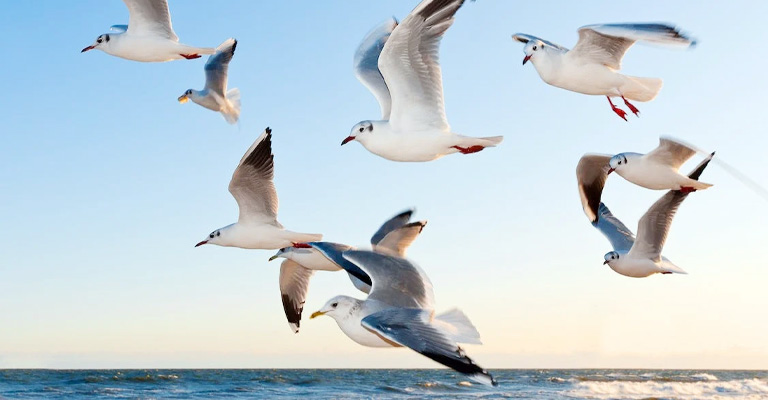
Adaptations of Seagulls in the Sea
Seagulls possess several unique physical traits that facilitate their aerial lifestyle. Their streamlined bodies, long and slender wings, and strong, lightweight bones allow them to maneuver skillfully through the air.
Their powerful beaks are well-suited for capturing prey or scavenging food from the water’s surface. Seagulls boast an impressive wingspan, enabling them to ride the wind currents effortlessly.
Their ability to hover, glide, and perform agile aerial maneuvers is essential for locating food sources and evading predators. Flight provides seagulls with a vantage point to survey vast areas for potential feeding opportunities.
Flight plays a crucial role in the survival of seagulls. It allows them to cover extensive distances in search of food, including fish, invertebrates, and carrion.
The flight also aids in escaping predators, locating suitable nesting sites, and communicating with other members of their flock.
Common Reasons Why do seagulls fly over the Sea?
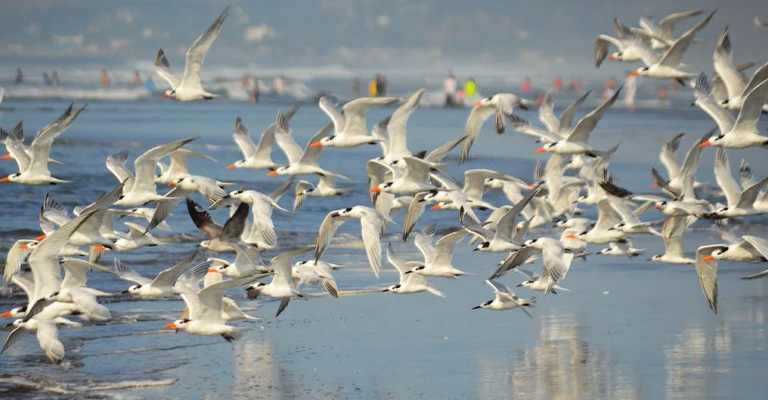
There are a few reasons why do seagulls fly over the sea. The most logically correct reasons are as followed.
Seagulls Find Foods In the Sea
Seagulls are opportunistic feeders with a diverse diet. They are known to consume fish, invertebrates, small mammals, and even human scraps. Their ability to fly over the sea allows them to access abundant food resources that are present in coastal and marine environments.
Seagulls exhibit both predatory behavior and scavenging tendencies. They are skilled hunters, using their keen eyesight to spot fish near the ocean surface.
Seagulls also take advantage of their flight capabilities to scavenge for food by following fishing boats or congregating near coastal areas where human activities provide additional food opportunities.
Flying over the sea provides seagulls with access to a rich and diverse food supply. The ocean is teeming with fish, mollusks, and crustaceans, which are essential components of their diet.
Seagulls Prefer the Environment of the Sea
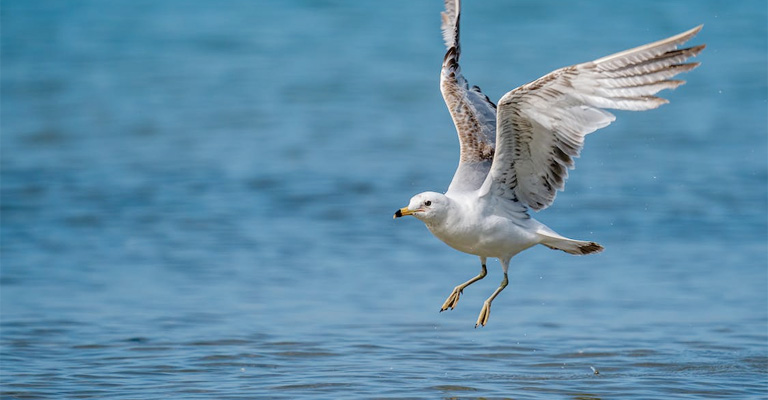
Seagulls are highly adapted to take advantage of weather patterns and wind currents. They use updrafts and sea breezes to minimize energy expenditure during flight, soaring effortlessly over the sea.
These air currents provide support and aid their movement, allowing them to cover long distances while conserving energy.
Seagulls’ Nesting and Breeding Habitats Near the Coast
Seagulls often establish their nesting and breeding colonies in coastal habitats, close to their primary food source, the sea.
These habitats provide seagulls with suitable nesting sites, such as cliffs, islands, or sand dunes, where they can rear their chicks and protect their nests from land-based predators.
Sea Has Less Predation Risk
By flying over the sea, seagulls minimize their exposure to land-based predators. The open expanse of water serves as a natural barrier, limiting access to potential threats.
Predators that pose a risk to seagulls on land, such as foxes or larger birds of prey, find it challenging to pursue them over the sea.
FewerLand-based Obstacles
Flying over the sea reduces the number of terrestrial threats and obstacles seagulls encounter. On land, they may face hazards like traffic, buildings, or human activities that disturb their nesting sites.
By staying over the water, seagulls can avoid such risks and find a relatively undisturbed environment.
Seagull’s Nesting Habits Near the Sea
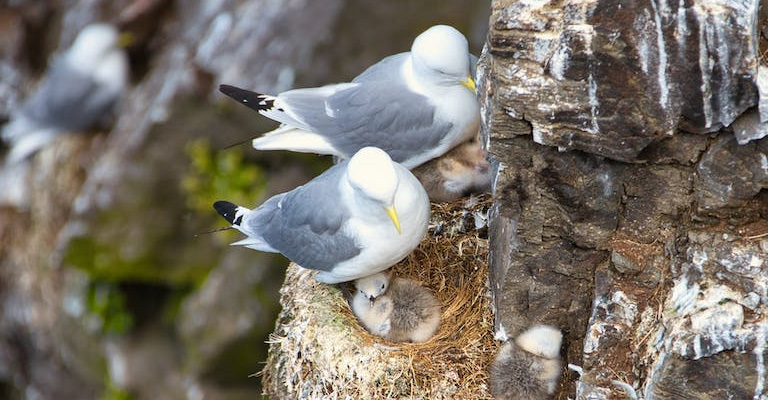
Seagulls exhibit nesting habits that contribute to their choice of flying over the sea. They often build their nests on cliff ledges or isolated islands, away from land-based predators.
By locating their nests in such locations, seagulls ensure the safety of their eggs and young, minimizing the risk of predation.
Seagulls Use to Migrate by Flying Over the Sea
Many seagull species are known to undertake long-distance migrations. They travel vast distances between their breeding grounds and wintering areas, relying on flight to navigate these migratory routes.
Flying over the sea during migration allows seagulls to capitalize on the food resources and favorable wind conditions found along the coastline.
Flying over the sea offers several advantages for seagulls during migration. It provides a direct and relatively obstacle-free path, minimizing the energy expenditure required to reach their destination.
The sea also acts as a visual guide, aiding in navigation and reducing the chances of getting lost during long-distance flights.
Seagull’s Communication and Social Behavior Around the Sea
Seagulls are highly social birds that often congregate in large flocks. Flocking provides several benefits, including increased foraging efficiency, predator detection, and mating opportunities.
Flying together over the sea allows seagulls to communicate and coordinate their movements, maximizing the advantages of social behavior.
Seagulls employ various communication methods during flight to convey information to other individuals in their flock. Vocalizations, body postures, and flight patterns play a vital role in signaling alarms, identifying food sources, or indicating potential nesting sites.
Human Coastal Activities Attracting Seagulls
Human activities along the coastline, such as fishing, tourism, and waste disposal, can attract seagulls. These activities provide additional food sources and opportunities for scavenging, drawing seagulls to fly over the sea and coastal areas in search of sustenance.
Human interference can have both positive and negative impacts on seagulls’ behavior. While some human activities may provide additional food resources, others, such as habitat destruction or disturbance, can disrupt their nesting sites and breeding success.
Careful management and conservation efforts are necessary to minimize negative impacts and maintain a healthy balance between seagulls and human activities.
Behavioral Patterns of Seagulls when seagulls flying over ocean
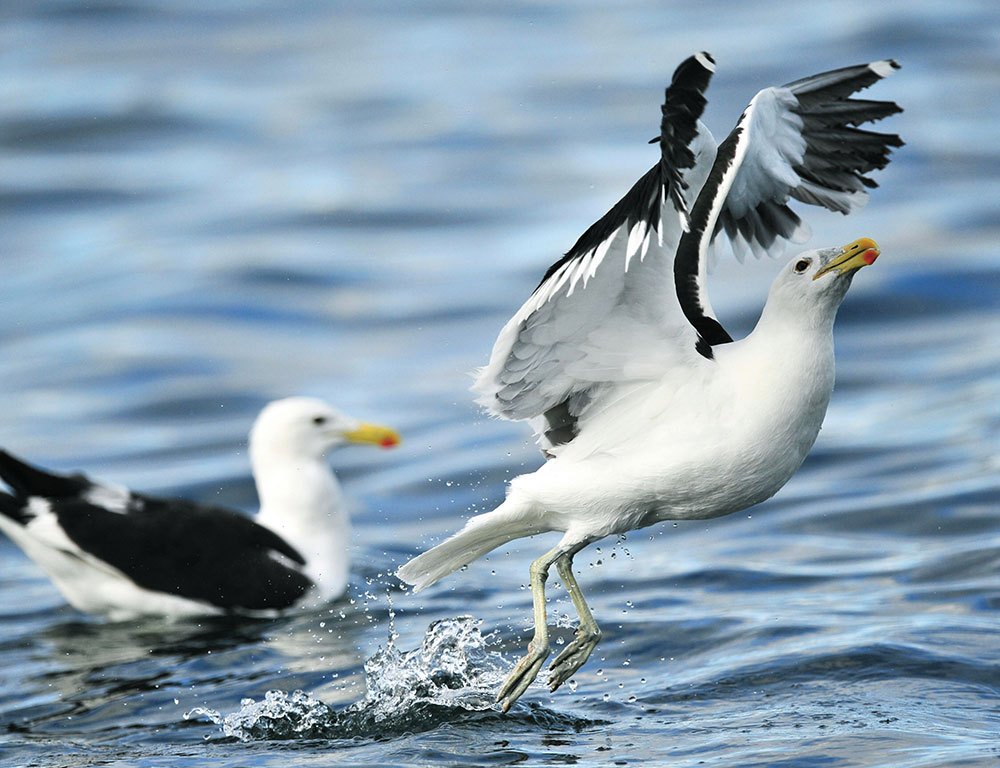
Seagulls are fascinating creatures known for their distinct behaviors. These birds demonstrate various patterns, including seasonal migration and unique fishing and feeding habits.
Seasonal Migration
One can’t discuss seagull behavior without touching on their migratory patterns. It’s during the colder months that most northern-latitude gulls head south to warmer climates. This isn’t just a casual journey; some species travel up to thousands of miles.
For example, the Franklin’s Gull is a long-haul migrator, flying from North America all the way down to South America. In contrast, other species like the Herring Gull don’t venture too far, often staying within North America but moving towards warmer coastal areas.
Fishing and Feeding Habits
Equally interesting are seagulls’ fishing and feeding behaviors. They’re opportunistic feeders which means they’ll eat almost anything available – from fish and marine invertebrates to garbage discarded by humans.
In particular, their fishing habits provide quite a spectacle. Some gulls hover over water before diving in for a catch while others float on the surface waiting for prey to appear below them.
However, it’s worth noting that not all gulls live strictly by the sea or exclusively eat seafood. For instance:
-
The Ring-billed Gull thrives near freshwater bodies across North America.
-
Grey Gulls adapt to desert environments near Pacific coasts.
-
Ivory Gulls brave icy conditions of Arctic regions with diets largely consisting of carrion and small fish under ice sheets.
Understanding these behavioral patterns helps us appreciate why seagulls fly over the sea as well as other diverse habitats where they find food and safety year-round.
Interactions with Other Marine Life
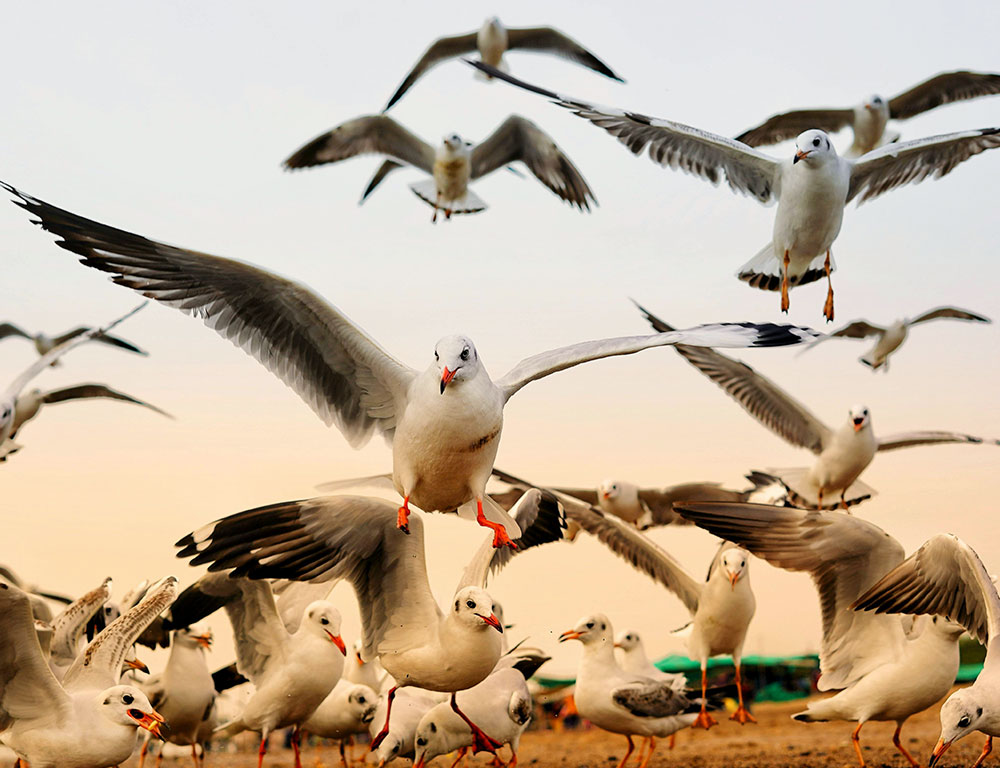
In addition to fish, seagulls also interact with other seabirds. For example:
-
They compete for nesting spots on cliffs and islands.
-
There can be conflicts over food resources.
-
Shared breeding grounds often lead to interesting social dynamics.
|
Interaction |
Impact |
|---|---|
|
Hunting Fish |
Helps control fish population |
|
Competition for Nesting Spots |
Leads to diverse bird populations in certain areas |
|
Food Conflicts |
Ensures only the fittest survive |
Furthermore, seagulls play an important role in nutrient cycling within marine ecosystems. After feeding at sea, they return to land and excrete waste that adds essential nutrients back into terrestrial systems.
FAQs
Seagulls fly over the sea for several reasons, including easy access to abundant food resources, reduced predation risk, and the availability of favorable wind currents for efficient flight.
Flying over the sea provides seagulls with a direct and obstacle-free route during migration. It allows them to conserve energy, navigate using visual cues from the coastline, and access food resources found along the coast.
Seagulls possess physical adaptations such as streamlined bodies, long wings, and lightweight bones, which enhance their flight capabilities. Their wingspan allows them to glide effortlessly, maneuver with agility, and take advantage of updrafts and sea breezes.
Yes, seagulls communicate through vocalizations, body postures, and flight patterns while flying over the sea. These forms of communication help them coordinate movements within their flock, signal alarms, identify food sources, and establish social hierarchies.
Human coastal activities attract seagulls due to the availability of additional food sources. Seagulls have adapted to human presence and may scavenge on discarded food.
However, human interference can also disrupt nesting sites and breeding success, requiring careful management and conservation efforts to mitigate negative impacts on seagulls’ behavior.
Wrapping Up
Even Though today you can see seagulls widely inland, seagulls are birds of coastal areas. And it’s natural to see them fly above the sea because in the end they like to use their long beaks to hunt down a fish or have delicious treats after stealing some fish from the fisherman’s boat.
Do you have any story of seagulls stealing your snacks? you can share with us in the comment section. Thank you for your time.